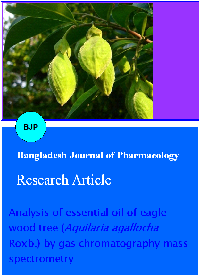Analysis of essential oil of eaglewood tree (Aquilaria agallocha Roxb.) by gas chromatography mass spectrometry
DOI:
https://doi.org/10.3329/bjp.v4i1.851Keywords:
Aquilaria agallocha, Eaglewood, Essential oil, GC-MS, OctacosaneAbstract
The study was carried out to find out the differences in composition of oils obtained from healthy, naturally infected and artificially screws wounds eaglewood (Aquilaria agallocha Roxb.) using gas chromatography mass spectrometry (GC-MS) analysis. Natural healthy plants agar contained octacosane (19.83%), naphthalene, 1,2,3,5,6,7,8,8a-octahydro-1,8a-dimethyl-7-(1-methylethenyl)-, [1R-(1.alpha.,7.beta.,8a.alpha.)]- (12.67%), 5-isobutyramido-2-methyl pyrimidine (13.52%), caryophyllene oxide (11.25%) and (.+-.)-cadinene (5.46%). Natural infected plants agar (super agar) contained cycloheptane, 4-methylene-1-methyl-2-(2-methyl-1-propen-1-yl)-1-vinyl- (46.17%), caryophyllene oxide (33.00%) and 7-Isopropenyl-4a-methyl-1-methylenedecahydronaphthalene (20.83%). Artificially screw injected plants agar contained diisooctyl phthalate (71.97%), 1H-Cycloprop[e]azulen-4-ol, decahydro-1,1,4,7-tetramethyl-, [1ar-(1a.alpha.,4.beta.,4a.beta., 7.alpha., 7a.beta., 7b.alpha.)]- (9.16%), hexadecanoic acid (7.05%), naphthalene, 1,2,3,5,6,7,8,8a-octahydro-1,8a-dimethyl-7-(1-methylethenyl)-, [1R-(1.alpha.,7.beta.,8a.alpha.)]- (6.45%) and aristolene (5.36%). This study showed a marked difference in the oil compositions among the treatments with regards to their quality.Downloads
4507
2840 Read
1170
References
Anonymous. The wealth of India: Raw materials. Vol 1. New Delhi, Publication and Information Directorate, CSIR, 1948, pp 88-90.
Beniwal BS. Silvical characteristics of Aquilaria agallocha Roxb. Indian Forest. 1989; 115: 17-21.
Bhandari P, Pant R, Rastogi RP. Aquillochin: A coumarinolignan from Aquilaria agallocha. Phytochemistry 1982; 21: 2147-49.
Bhattacharyya B, Datta A, Baruah HK. On the formation and development of agaru in Aquilaria agallocha. Sci Cult. 1952; 18: 240- 41.
Bose SR. The nature of 'Agaru' formation. Sci Cult. 1938; 4: 89-91.
Clevenger JF. Apparatus for determination of volatile oil. J Amer Pharm Assoc. 1928; 17: 346.
Gibson IAS. The role of fungi in the origin of oleoresin deposits (Agaru) in the wood of Aquillaria agallocha (Roxb.). Bano Biggyn Patrika. 1977; 6: 16-26.
Ishihara M, Tsuneya T, Uneyama K. Fragrant sesquiterpenes from agarwood. Phytochemistry 1993; 33: 1147-55.
Ishihara M, Tsuneya T, Uneyama K. Guaiene sesquiterpenes from agarwood. Phytochemistry 1991; 30: 3343-47.
Jalaluddin M. A useful pathological condition agarwood. Econ. Bot. 1977; 31: 222-24.
Maheshwari ML, Jain TC, Bates RB, Bhattacharyya SC. Structure and absolute configuration of ?-agarofuran, ?-agarofuran and dihydroagarofuran. Tetrahedron. 1963; 19: 1079-90.
Mitra J, Gogoi P. Fungi associated with the diseased wood (agarwood/agaru) of Aquilaria agallocha Roxb. (Family: Thymelaeaceae) grown in Assam. Proceedings of seminar on scope and dimension of agarplantation in NE region Ahmed M, Gogoi P, Ahmed GU, Hojai AATMA (eds). India, 2001, pp 61-69.
Nagashima T, Kawasaki I, Yoshida T, Nakanishi T, Yoneda K, Miura I. New Sesquiterpenoids from agarwood. Paper IXth International essential oil congress. Singapore, 1983, pp 12-16.
Nakanishi T, Yamagata E, Yoneda K, Nagashima T, Kawasaki I, Yoshida T, Mori H, Miura I. Three fragrant sesquiterpenes of agarwood. Phytochemistry 1984; 22: 2066-67.
Okugawa H, Ueda R, Matsumoto K, Kawanishi K, Kato A. Effect of Agarwood on the central nervous system in mice. Planta Medica. 1993; 59: 32-36.
Paknikar SK, Naik CG. Stereochemistry of dihydroagarofurans and evidence in support of the structure of 4,11- epoxy-cis-eudesmane. Tet Lett. 1975; 15: 1293-94.
Pant P, Rastogi RP. Agarol, a new sesquiterpene from Aquilaria agallocha. Phytochemistry 1980; 19: 1869-70.
Qi Shu-Yuan, Lu Bi-Yau, Zhu Liang-Feng, Li Bao-Ling. Formation of oxoagarospirol in Aquilaria sinensis. Plant Physiol Commun. 1992; 28: 336-39.
Tamuli P, Boruah P. Changes in amino acids in agarwood plant under pathological condition. Geobios. 2002a; 29: 241-43.
Tamuli P, Boruah P. Vesicular-arbuscular mycorrhizal (VAM) association of agarwood tree in Jorhat district of the Brahmaputra Valley. Indian Forest. 2002b; 128: 991-94.
Tamuli P, Boruah P, Nath SC. Essential oil of eaglewood tree: A product of pathogenisis. J Essent Oil Res. 2005; 17: 601-04.
Tamuli P, Boruah P, Nath SC, Samanta R. Fungi from diseased agarwood tree (Aquilaria agallocha Roxb.): Two new records. Adv Forest Res India 2000a; 22: 182-87.
Tamuli P, Boruah P, Nath SC, Samanta R. Mycofloral study on the phyllosphere and soil of agarwood tree plantation. U.G.C. Sponsored seminar on conservation of biodiversity, Assam, 2000b; p 5.
Thomas AF, Ozainne M. The stereochemistry of the dihydroagarofurans. Tet Lett. 1976; 20: 1717-18.
Varma KR, Maheshwari ML, Bhattacharyya SC. The constitution of agarospisol, a sesquiterpenoid with a new skeleton. Tetrahedron 1965; 21: 115-38.
Venkataramanan MN, Borthakur R, Singh HD. Occurrence of endotrophic myccorhizal fungus in agarwood plant Aquilaria agallocha Roxb. Curr Sci. 1985; 54: 928.

Additional Files
Published
How to Cite
Issue
Section
License
Authors who publish with this journal agree to the following terms:
- Authors retain copyright and grant the journal right of first publication with the work simultaneously licensed under a Creative Commons Attribution License that allows others to share the work with an acknowledgement of the work's authorship and initial publication in this journal.
- Authors are able to enter into separate, additional contractual arrangements for the non-exclusive distribution of the journal's published version of the work (e.g., post it to an institutional repository or publish it in a book), with an acknowledgement of its initial publication in this journal.
- Authors are permitted and encouraged to post their work online (e.g., in institutional repositories or on their website) prior to and during the submission process, as it can lead to productive exchanges, as well as earlier and greater citation of published work (See The Effect of Open Access).
